The much anticipated sequel to Ico and Shadow of the Colossus was finally released, and it did not disappoint. Designer and creator Fumito Ueda and Team Ico presented a magical tale between the wild creature Trico and the unnamed boy that tames it, crawling through dungeons and solving puzzles together. The Last Guardian lives up to the expectations, but the narrative is ambigeous. I propose a close-reading of the game through its main themes – spiritual tattoos and shamanism. This is a story of blood and ink, as much as it is of pixels.
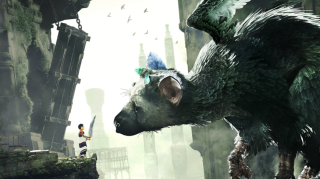
Though there is perhaps no plot connection between The Last Guardian and the previous games, the narrative itself appears to be part of the same world. Thematically, there is also a strong connection between the three stories – companionship, sacrifice and our relationship with nature.
Sacrifice and technology are connected in this game. The antagonist is The Master of The Valley, a technological (or perhaps magical) entity that has mind-controlled Trico’s race. The creatures sacrifice young children to the entity and our protagonist was originally meant to be sacrificed as well. Online discussions speculated about the ending of the game and what becomes of these children, and in this close-reading, I will also tackle this topic.
The tattoos, I suggest, are key to understanding this game. Fans speculated about their meaning, and I take this as the main starting point of the blog.
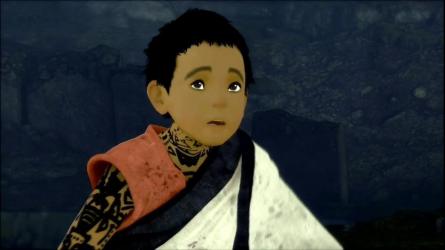
Magical Tattoos
In Tattoos, Desire and Violence, Karin Beeler argues that reading tattoos in pop-culture requires an anthropological approach: “Tattoo narratives may be stories of desire, of trauma, of violence, and of cultural preservation – stories that are initially connected to the symoblic and physical or bodily aspects of the tattoo” (p. 3).
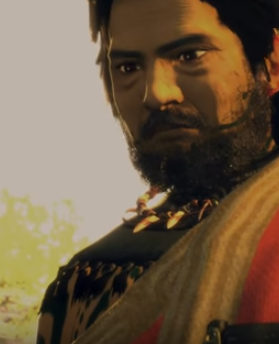 The protagonist of The Last Guardian is characterized by his tattoos. Both as a young character and old man (also the narrator of the game), he is portrayed as a shaman, a spiritual master and healer. His cloth, tattoos, and his jewelry all fit the shamanistic tradition. Also take note of the fact that he now wears jewelry – a necklace of animal teeth.
The protagonist of The Last Guardian is characterized by his tattoos. Both as a young character and old man (also the narrator of the game), he is portrayed as a shaman, a spiritual master and healer. His cloth, tattoos, and his jewelry all fit the shamanistic tradition. Also take note of the fact that he now wears jewelry – a necklace of animal teeth.
Compare him to the natives which are featured throughout the game, none of which have tattoos. In the village, he stands out. When he is introduced again, his shadow looms over the boys who find the shield. He seems to have a priest-like status. After all, he is the only one who survived the creatures attack and lived to tell the tale.
Tattoo anthropologist Lars Krutak blogged about magical tattoos and their relation to the shaman:
For millennia, nearly all indigenous people who tattooed practiced shamanism, the oldest human spiritual religion. Death was the first teacher, the boundary beyond which life ended and wonder began. Shamanistic religion was nurtured by mystery and magic, but it was also born of the hunt and of the harvest and from the need on the part of humans to rationalize the fact that they had to kill that which they most revered: plants, animals, and sometimes other men who competed for resources or whose souls provided magical benefits.
In many cultures (eg. Ancient Greek), tattoos were also a sign of marginality, branding outcasts such as criminals or slaves. I do not think this meaning matters very much in our game, though the boy has left his society. His tattoos have a more friendly connotation, which also reminded me of the classic anthropological study by Margaret Mead, Coming of Age in Samoa. In this society, like in many other primitive societies, tattoos were given to natives when they came of age. The tattoos of the boy perhaps also are a sign that he is maturing and adulting. They can be read as magical and spiritual scars, but also a coming of age sign.
Remember how Ueda has been inspired by the Zelda games in his work? This becomes explicit in Ico, but also in this game. In the Zelda series, we have an important mentor character who is also often framed as a shaman, Impa. Her tattoos are crucial as they serve a spiritual, wise, and native function. She is depicted as a great warrior in the latest games, and the tattoos support this. They are signs of battle. But most importantly, they are her Sheikah heritage.
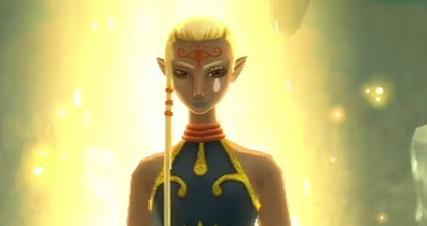
Sacrifice and Religiosity
In Spiritual Tattoos, Andrew Rush writes that tattoos are “painful paths” which act as corridors connecting to a side of our mind that connects to that “other”, that energy source that informs all”. This energy is what we look for in religion, and what we want to transcend to. Pain and suffering prepare us for this spiritual life. Tattoos and scars leave us partly in the spiritual world and partly in the mundane.
Rush writes about tattoos as signs of transcendence and worship. This also strikes a chord, since the creatures from The Last Guardian worship the entitity in the valley, make sacrifices to him, and gain new energy as a reward from him. The Master of The Valley can be understood as a deity. What we are presented with is not an ordinary tale, but a myth closely connected (as all traditional myths) to religiosity.
Tattoos, then, are a cultural history of our pain, which is intimately connected to spirituality and transcendence. In the game, the tattoos seem to develop after we lose conciousness, which is directly presented in the game by a fade to black. It is suggested that we die, or perhaps border on life and death, and are then resurrected by Trico.
The young boy emerges out of the blue magical goo (the same goo that the creatures contain the sacrifices in) with more signs on his body, which symbolize life and death. This process is magical and destructive, and almost cocoon like. In the beginning, we do not know what is really happening, but at the end we finally see these moments represented when we see the other sacrifices.
This is how Trico also contains us, the main character, either to protect us, or to resurrect us. He swallows us, and covered in signs, spits us out:
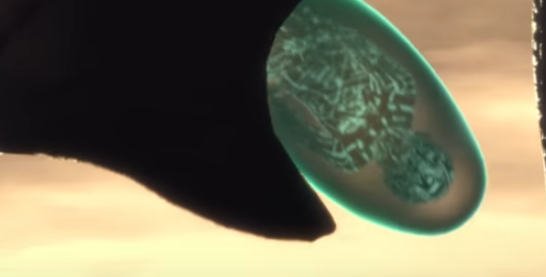
The sacrificed children are covered in signs similar to ours – these very signs are imprinted on the skin of the main character. The tattoos are pure magic and energy, branded on our skin.
Scars and Physical Trauma
While tattoos are self-inflicted, and made by ink, scars are damage of the tissue. Tattoos are a form of body modification whereas a scar is connected to trauma, hurt and pain. Though the game represents these patterns in a dark color, almost like ink, it is perhaps not correct to speak of tattoos but of scars. These are physical signs of hurt, pain and battle that are imprinted on our skin. These signs are not man-made, but magical and spiritual.
This is what remains of the raw energy which flowed through the boy’s body, and reanimated him. This is the same blue energy that we see in the horns of the beasts, their eyes, and even in one shot in the protagonist vacant eyes before Trico kidnaps him.
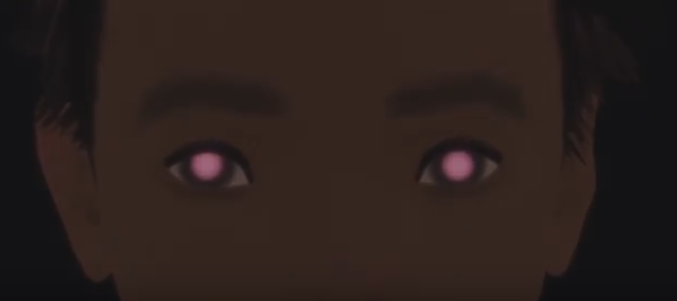
As soon as we consider these tattoos as scars, a connection with Shadow of the Colossus emerges. In this game, we see Wander degenerate more and more as he slays the collossi (the Gods of the island) one by one to resurrect his beloved. At the end of the game, he becomes a collossus himself and is slayed by the natives. The Last Guardian mirrors this narrative – the beast (willingly) gives us his energy to regenerate us, and as a result our body changes. The creature and the boy are in a more harmonious relationship than Wander and the collossi, and indeed, this relationship reminds us of Wander and his horse Agro.
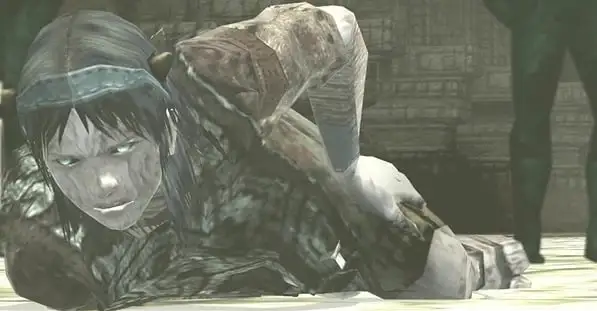
Many fans wondered where the connection was between The Last Guardian and Shadow of the Colossus and Ico. I feel it’s overtly there, not just in its theme and its archaic setting, but also in its plot. The 2016 game perfectly blends the tropes of the previous games, and continues the trilogy by allowing us to connect with a colossus on a deeper level. This intimate friendship is beautiful. While the animal may have started out hostile, and indeed with the intention to sacrifice us, we tame it and gradually learn to love it.
We become dependent of Trico, and this mutual dependency really is the heart of the game, and beautifully simulated in the game play itself. The tattoos prove our love for Trico, and the sacrifice that Trico made – his magical energy kept us alive throughout the game.
Last questions
Related to this discussion, let me answer to questions that I have seen on game forums and YouTube.
What is in the sacrophage at the beginning of the game? Fans speculated that the sacrophage we see in the beginning is that of The Master of The Valley, whose conciousness is now mediated into an AI. Considering how the room resembles the tower from Shadow of the Colossus, I would argue that the sacrophage might represent the very last colossus – Wander himself. (One might wonder here if being the Master and being Wander are mutually exclusive?)
Who is The Master of The Valley? Since technology versus nature is a main theme of this game, I assume that this being is technological and perhaps created by those who lived in this society long ago. I get an Atlantis sort of feeling here (eg. Disney’s Atlantis and Fate of Atlantis). This is a long-forgotten device which runs on a unique energy source. The fact that the protagonist personifies this machine as “The Master”, does not necessarily mean that it is concious. The energy in the machine responds to our touch, so I do think that whatever energy runs through this device is sentient. In other words, not the machine, but the life energy, is animated.
What is in the barrels? Life force (also spiritual energy) which is harvested from the children. Part of it might go to the “pool” (Master of The Valley) and some of it is a reward for the Tricos. I assume this is also what makes the mechanic knights tick. Some of it is fed to you when you are resurrected. Yup, this is a brutal and deep game.

This is an immensely well thought out essay. I agree with most of these theories. Thank you for writing this out so well. I think it’s also interesting to see the possible parallel between the reflecting mirror and the sword of light from SOTC. That could possibly help to further substantiate your theory of Wander’s connection to the this game. Excellent!
Leanna, that is such a good observation and so true! I hadn’t thought of that yet but it completely works! 😀